Design Day Fall 2022
Design Day is an opportunity to share our Senior Design Showcase with the public. Seniors work in groups with faculty to design and test projects.
Senior Design Projects: Fall 2022
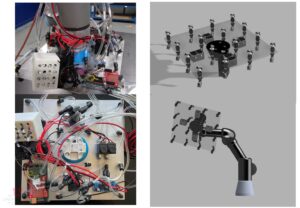 The scope of the Albany Engineered Composites Automated Ply Handling Robot project is to finalize a 1ft-by-1 ft 16-point vacuum cup array end effector for handling carbon fiber plies. This will work in conjunction with a provided UR Robot and its movement control capabilities. The end effector will be separately controlled to allow for the handling of different shaped and sized plies, ensuring a myriad of project capabilities. To ensure product quality and operational implementation we shall explore potential issues of material contamination, prepreg damage, foreign object debris, robot error handling and consistent function. We intend to have a industry capable end effector that our sponsor can use to integrate into their control systems to improve the process of handling and stacking plies off of the CNC cutter table.
The scope of the Albany Engineered Composites Automated Ply Handling Robot project is to finalize a 1ft-by-1 ft 16-point vacuum cup array end effector for handling carbon fiber plies. This will work in conjunction with a provided UR Robot and its movement control capabilities. The end effector will be separately controlled to allow for the handling of different shaped and sized plies, ensuring a myriad of project capabilities. To ensure product quality and operational implementation we shall explore potential issues of material contamination, prepreg damage, foreign object debris, robot error handling and consistent function. We intend to have a industry capable end effector that our sponsor can use to integrate into their control systems to improve the process of handling and stacking plies off of the CNC cutter table.
Team: Victor Leao-David, Caleb Bost, Darrick Minshall, Chase Lee
Faculty Advisor: Dr. Stephen Mascaro
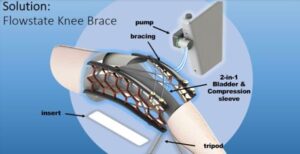 Our product addresses the problems that arise in knee injury and recovery from osteoarthritis: swelling, pain, and instability. No brace on the market is designed to fit the needs of the individual because people are different from one another. Our design allows the knee brace to be personalized and tailored to individuals and their needs.
Our product addresses the problems that arise in knee injury and recovery from osteoarthritis: swelling, pain, and instability. No brace on the market is designed to fit the needs of the individual because people are different from one another. Our design allows the knee brace to be personalized and tailored to individuals and their needs.
Team: Connor Casaday, Caleb Grayston, Kaitlyn Platt (lead), Trey Roeseler
Advisor: Dr. Haohan Zhang
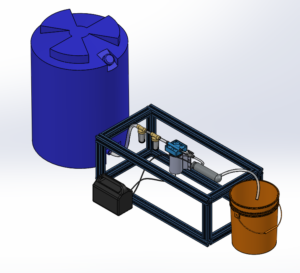 Our project is an off-grid water treatment system for water from the Lower Bell Canyon Reservoir. It filters out suspended solids and biological hazards while running on solar power.
Our project is an off-grid water treatment system for water from the Lower Bell Canyon Reservoir. It filters out suspended solids and biological hazards while running on solar power.
Team: Henry Cagle, Lexi DeFord (lead), Julia Dittrich, Christian Lucas
Advisor: Dr. M Metzger
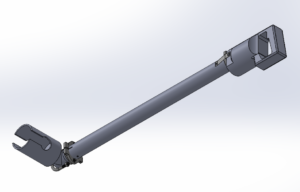 The purpose of the Cell Tarp Roller Drive for Rio Tinto is to roll and unroll the tarps used to maintain heat in the electrolytic vats that they use to refine copper plates.
The purpose of the Cell Tarp Roller Drive for Rio Tinto is to roll and unroll the tarps used to maintain heat in the electrolytic vats that they use to refine copper plates.
Team: Braden Mulvey, Dustin Snedeger (lead), Jared Timmons, Taylor Ward
Advisor: Dr. Shad Roundy
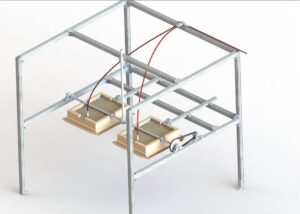 Reduce the overall production cycle time by at least 15% for casting of GFRC products all whilst identifying possible automation opportunities that will increase production throughput, reduce labor and production costs, and provide efficient energy-saving solutions.
Reduce the overall production cycle time by at least 15% for casting of GFRC products all whilst identifying possible automation opportunities that will increase production throughput, reduce labor and production costs, and provide efficient energy-saving solutions.
Team: Rashid Bakare, Corbin Dawkins (lead), Josh Fisher, Duncan Foster, Erick Solum
Advisor: Dr. Ashwin Reganathan
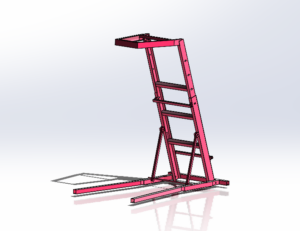 Albany Engineered Composites is looking for an ergonomic solution to their manual layup manufacturing process. The layup process requires technicians to lay carbon fiber plies on a large forming tool that puts the technicians in unsafe and harmful positions. Our design goal is to allow access to various technicians (25th percentile female to 95th percentile male) and eliminate any unsafe position that were previously required. Our design uses a top side creeper as a base and a few redesigns to maximize the reach and accessibility for the technicians.
Albany Engineered Composites is looking for an ergonomic solution to their manual layup manufacturing process. The layup process requires technicians to lay carbon fiber plies on a large forming tool that puts the technicians in unsafe and harmful positions. Our design goal is to allow access to various technicians (25th percentile female to 95th percentile male) and eliminate any unsafe position that were previously required. Our design uses a top side creeper as a base and a few redesigns to maximize the reach and accessibility for the technicians.
Team: Suzi Creveling (lead), Jacob Mellberg, Sam Nelson, Nathan Reimann, Peter Vroom
Advisor: Dr. Ken d’Entremont
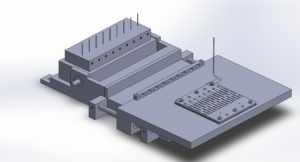 The key scope and focus of this project is to design a method that will connect the ribbons and wires to a vacuum side pin on a multibeam X-ray tube. The methods employed will need to have the dexterity and efficiency of connecting these pins such that manual labor and costs are reduced. Furthermore, the ideal solution would be to eliminate the manual process of connecting each pin by hand, thereby limiting the contact time required for installation within the chambers of the X-ray tube and eliminating the potential for damage or contamination.
The key scope and focus of this project is to design a method that will connect the ribbons and wires to a vacuum side pin on a multibeam X-ray tube. The methods employed will need to have the dexterity and efficiency of connecting these pins such that manual labor and costs are reduced. Furthermore, the ideal solution would be to eliminate the manual process of connecting each pin by hand, thereby limiting the contact time required for installation within the chambers of the X-ray tube and eliminating the potential for damage or contamination.
Team: Anthony Eiting, Sophie Milne, Francisco Montano, Adam Tingey, Ben VanDyke (lead)
Advisor: Dr. Hoahan Zhang
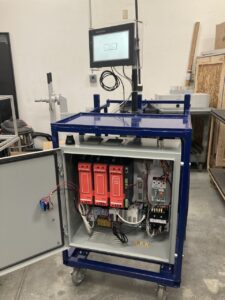 Varex Imaging is in need of a new heat exchanger testing machine to help test new and existing heating exchangers for their X-ray applications. The heat exchanger testing machine they currently use only houses one oil type at a time, and switching between oil types is a time consuming process that can take hours. Their current testing machine requires the operator to manually adjust the power inputted into the system at different levels until steady state is reached. Once steady state is reached the operator needs to manually monitor and collect data from sensor readings positioned at different places on the heat exchanger. That data is later processed and the performance of the heat exchanger can be determined. Varex Imaging decided that their current testing machine is both inaccurate and inefficient for those operating it. The focus of our project is to design, manufacture, and test a new heat exchanger testing machine for Varex Imaging. They want the heat exchanger test machine to accommodate two oil types. They also want the updated testing machine to autonomously run the entire test on the heat exchanger. Meaning it could detect steady state autonomously and adjust the energy inputted into the system through its programming. Varex would also like the new testing machine to be user friendly by implementing a Human Machine Interface (HMI) where the operator could have full control of the test with one touch screen. Lastly to help increase the accuracy of the test Varex wants the power to be controlled through a feedback loop to ensure we can accurately determine how much energy is being inputted into the heat exchanger being tested.
Varex Imaging is in need of a new heat exchanger testing machine to help test new and existing heating exchangers for their X-ray applications. The heat exchanger testing machine they currently use only houses one oil type at a time, and switching between oil types is a time consuming process that can take hours. Their current testing machine requires the operator to manually adjust the power inputted into the system at different levels until steady state is reached. Once steady state is reached the operator needs to manually monitor and collect data from sensor readings positioned at different places on the heat exchanger. That data is later processed and the performance of the heat exchanger can be determined. Varex Imaging decided that their current testing machine is both inaccurate and inefficient for those operating it. The focus of our project is to design, manufacture, and test a new heat exchanger testing machine for Varex Imaging. They want the heat exchanger test machine to accommodate two oil types. They also want the updated testing machine to autonomously run the entire test on the heat exchanger. Meaning it could detect steady state autonomously and adjust the energy inputted into the system through its programming. Varex would also like the new testing machine to be user friendly by implementing a Human Machine Interface (HMI) where the operator could have full control of the test with one touch screen. Lastly to help increase the accuracy of the test Varex wants the power to be controlled through a feedback loop to ensure we can accurately determine how much energy is being inputted into the heat exchanger being tested.
Team: Nate Gricius, Christian Mota, Taylor Summers (lead), Cody Wareham
Advisor: Dr. Sameer Rao
 The goal of the project is to automate the testing procedure for coupon specimens. This will be done with a robotic arm and an Instron test stand. The robotic arm will be controlled via a user interface and conduct mechanical tests with minimal human interaction. Pictures of the coupon specimens before and after the tests will be stored in an HDF5 file along with the relevant testing data. This project will make the testing process cheaper, faster, and more accurate for NASA.
The goal of the project is to automate the testing procedure for coupon specimens. This will be done with a robotic arm and an Instron test stand. The robotic arm will be controlled via a user interface and conduct mechanical tests with minimal human interaction. Pictures of the coupon specimens before and after the tests will be stored in an HDF5 file along with the relevant testing data. This project will make the testing process cheaper, faster, and more accurate for NASA.
Team: Devon Bowles (lead), Jared Duffy, Thomas McMaster, Michael Puttick
Advisor: Dr. Jacob Hochhalter